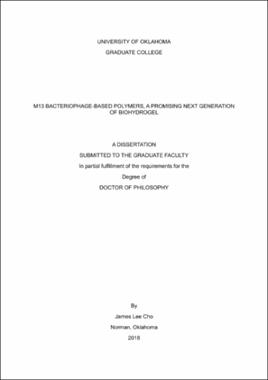| dc.contributor.advisor | Mao, Chuanbin | |
| dc.contributor.author | Cho, James | |
| dc.date.accessioned | 2018-12-10T22:01:26Z | |
| dc.date.available | 2018-12-10T22:01:26Z | |
| dc.date.issued | 2018-12-14 | |
| dc.identifier.uri | https://hdl.handle.net/11244/316307 | |
| dc.description.abstract | Hydrogel has been considered a promising material for many biomedical applicational researches due to its unique properties. One such promising hydrogel is a peptide-based hydrogel due to its excellent biocompatibility and bioinjectability, which are important properties for most biomedical applicative research. However, synthesis of peptide is a biohazardous, difficult, and expensive process. M13 phage can be a better alternative biomaterial as a monomer for constructing a good hydrogel because of easy amplification process, cost efficiency, and safe, bio-green chemical production. In this thesis article, copper-M13 phage hydrogel shows a good cytotoxicity to breast cancer cell lines via pH-controlled release of copper (II) ion-phage complex at body temperature 37oC. Gold (III)-M13 phage hydrogel has been constructed via metal-beta amyloid peptide interaction in a stable form in various aqueous biochemical media. It induces fine gold nanoparticle synthesis after the reduction of gold (III) ion by phages in the hydrogel. M13 phage-based hydrogel has a great potential to become a next generation biopolymer in the near future. | en_US |
| dc.language | en_US | en_US |
| dc.subject | M13 bacteriophage Hydrogel Metal ions | en_US |
| dc.title | M13 BACTERIOPHAGE-BASED POLYMERS, A PROMISING NEXT GENERATION OF BIOHYDROGEL | en_US |
| dc.contributor.committeeMember | Halterman, Ronald | |
| dc.contributor.committeeMember | Yip, Wai Tak | |
| dc.contributor.committeeMember | Yang, Zhibo | |
| dc.contributor.committeeMember | Harrison, Roger | |
| dc.date.manuscript | 2018-12 | |
| dc.thesis.degree | Ph.D. | en_US |
| ou.group | College of Arts and Sciences::Department of Chemistry and Biochemistry | en_US |
